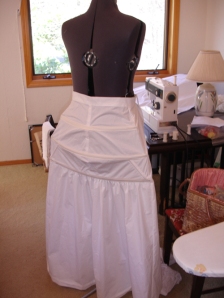Behind every queen is a prime minister. And behind every Victorian lady is … a bustle. Many of you know I'm a costumer, so Camy T. suggested I spend a couple of blog entries talking about sewing. With a number of steampunk events coming up this summer, and to get into the spirit of the steampunk YA novel I'm working on, I wanted to make a gown. However, you need a good foundation for clothes from the Victorian age, because they won’t hang properly otherwise. So the thing to do is to start with a corset (Period Corsets has good ones) and a bustle petticoat.
I got my petticoat pattern from Truly Victorian (pictured).
Then it was off to the fabric store for white cotton sheeting. I got 100% cotton, but girls, think about ironing 27 feet of ruffles. Not gonna happen. So the next time I make this up, I’ll use a 65/35 poly/cotton blend.
Lay out the pattern, cut out and mark the pieces, and you have a pile-o-stuff on your table.
 The pieces are large and the instructions clear, so it doesn’t take long for this to go together. Even the boning channels are straightforward, and you can buy the bones--big honkin’ metal ones with plastic tips that won’t poke through your fabric--from Truly Victorian, already cut to size. I can’t tell you how much time and aggravation that saves.
The pieces are large and the instructions clear, so it doesn’t take long for this to go together. Even the boning channels are straightforward, and you can buy the bones--big honkin’ metal ones with plastic tips that won’t poke through your fabric--from Truly Victorian, already cut to size. I can’t tell you how much time and aggravation that saves.
 Now, you’ll notice that the bones don’t look very bustle-y. That’s because we now have to put the bend in the bones. You sew strings into the seam allowance on each end of the bones, then pull them together over your, er, posterior and tie them, forming half-hoops.
Now, you’ll notice that the bones don’t look very bustle-y. That’s because we now have to put the bend in the bones. You sew strings into the seam allowance on each end of the bones, then pull them together over your, er, posterior and tie them, forming half-hoops.
Then it’s time for the ruffle overlay. Since the only person who can carry off the bony look successfully is Kate Moss, I don’t want the bones showing through my skirt. One must maintain the element of mystery, after all. So over the whole contraption goes a ruffled overlay to soften the lines of the bustle and hold the skirt off the bones a bit.

Ruffles. Oy. It took me a week to sew them--and since you lay them on top of the overlay pieces, you need to "finish" them or they’ll ravel with use. So that means sewing lace and ribbon on top of each one--meaning you sew all that acreage three times. Can you even imagine doing this in Victorian times, without a sewing machine?
 But voila, the finished product is worth it--and now we have the foundation to build the rest of the costume on. More about that next time!
But voila, the finished product is worth it--and now we have the foundation to build the rest of the costume on. More about that next time!
Shelley
4 comments:
Neat.
WHOA! That took talent and time. Great job, it came out amazing! :)
-makay
awesome! I too am a costumer and know how incredibly time consuming, but awesomely rewarding sewing can be.
That looks amazing... Very inspiring. Thanks for sharing!
Post a Comment